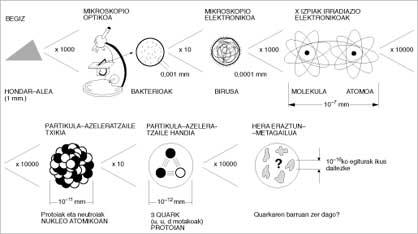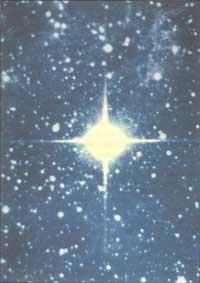New hypothesis on SN1987
1990/02/01 Arregi Bengoa, Jesus Iturria: Elhuyar aldizkaria
Elhuyar. From the foregoing issue of Science and Technology, it can be assumed that the SN 1987-A supernova will remain the subject of scientific observations and theoretical studies for a long time. In Nature has appeared an article on the pulse that has already been created with the supernova, approaching the explanation of its surprising particularities.
Authors J. A. Friedman and A.V. They are Olinto and propose a radical innovation when addressing the issue. Although so far astrophysicists have considered networks to be neutron stars, the aforementioned scientists have dared to deny this basis. According to them, the star's raw material would be a surprising material. This qualifier is not arbitrary. It responds to a physical concept with a very concrete meaning. But to understand it we will have to talk a little about the basic elements of matter.
All types of slaughterhouse known in the universe and their interactions can be explained through a few particles that are classified into three groups: leptoi, quark and bosons. As is known, the types of interaction of matter are four: force of gravity, electromagnetic force, violent interaction and weak interaction. The first two are well known and we know that their radius of action is infinite. The effects of the other two are only visible at a very short distance (10-15 m). Violent interaction is what unites protons and neutrons in the nuclei of the elements. Weak, however, is the one that causes the disintegration of certain nuclei and particles.
We briefly described particle groups. Leptois are six elementary particles that do not intervene in a violent interaction: the electron and the electronic neutrino, the hill and the muonic neutrino and the tau particle and the neutrino tau. Quarks are elementary particles involved in violent interaction. There are also six: u (“up” or above), d (“down” or below), c (“charm” or charm), s (“strange” or surprising), t (“top” or top) and b (“bottom” or bottom). The different combinations of quarks generate particles that we call hadrones. Among them, for example, there are protons and neutrons, and their structures are: uud and udd .
Violent interaction is also responsible for the connection between quarks. Finally, we will mention the bosons. They are particles that transmit forces or interactions: the change of gravitons transmits the force of gravity; the most virtual photon transmits the electromagnetic force; that of gluons (there are 8 types) the violent interaction, and that of the W and Z bosons the weak interaction. Of course, in addition to all these particles, we must take into account their antiparticles. But among all of us we will only deal with the s quarka, since in conditions such as those given in a pulse network can adopt very special properties, such as stabilization. The particle physics part that studies interactions and behavior between quarks, quantum chromodynamics, or briefly QCD (of the Quantum Chromodynamic) is called.
According to their first development, only quarka and quarka (when protons are formed) would be stable. However, according to some of the works published in recent times, as already mentioned above, it seems to be shown that even the s quarks, at least in some circumstances, can be stable. Placing a set of cores under very demanding pressure conditions can lead to such a process. At some point of increased pressure, neutron and proton would undergo a transition to organize as a new maternal state. In this situation we could not say that quarks were part of this type of neutrons or protons, because somehow the boundaries between them would disappear. That is, we would have a plasma of quarks. In it u and d quarks would generate s quarks increasing their concentration. This “surprising” matter composed of s quarks would be stable and the force of achievement would not be the force of gravity, but violent interaction.
These studies are initiated by Friedman and Olinto to work on the hypothesis that the network created with the SN 1987-A, instead of being formed by neutrons, is formed by “surprising” subjects. This hypothesis could also be applied to other pulsars, helping to explain the rare peculiarities that we have mentioned in the previous numbers.
To finish, one more note. If one were to demonstrate the existence of a surprising matter, one would have to recognize that many objects can have a much greater mass than what has been considered. This would give clarity to the problem of the dark mass or matter of the universe.

Gai honi buruzko eduki gehiago
Elhuyarrek garatutako teknologia





